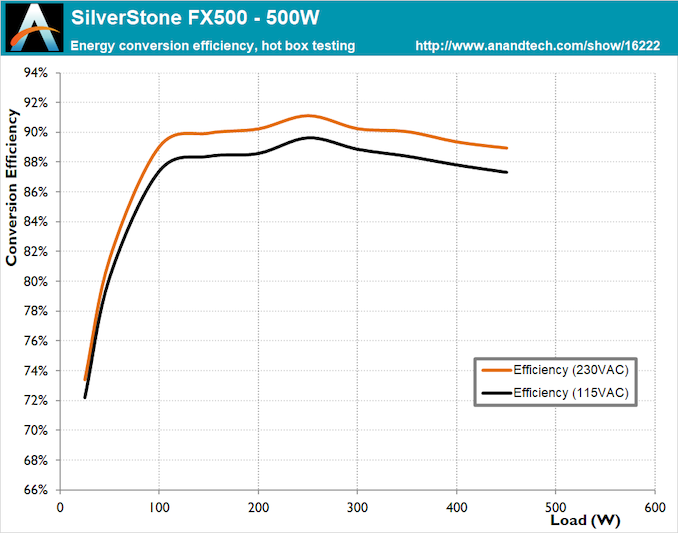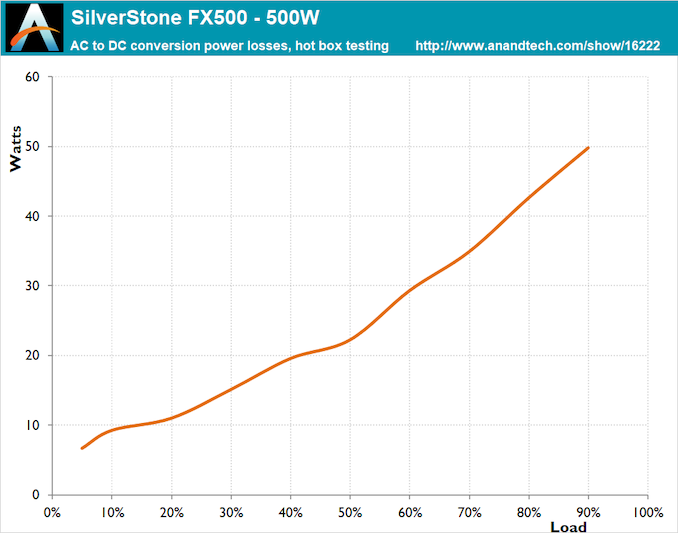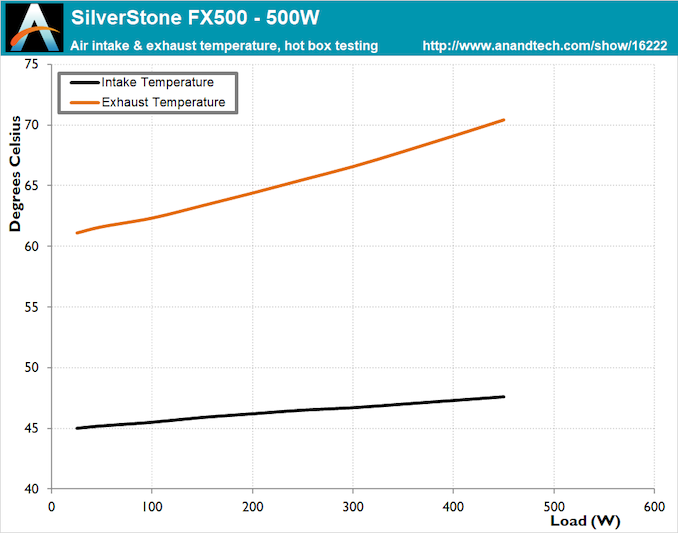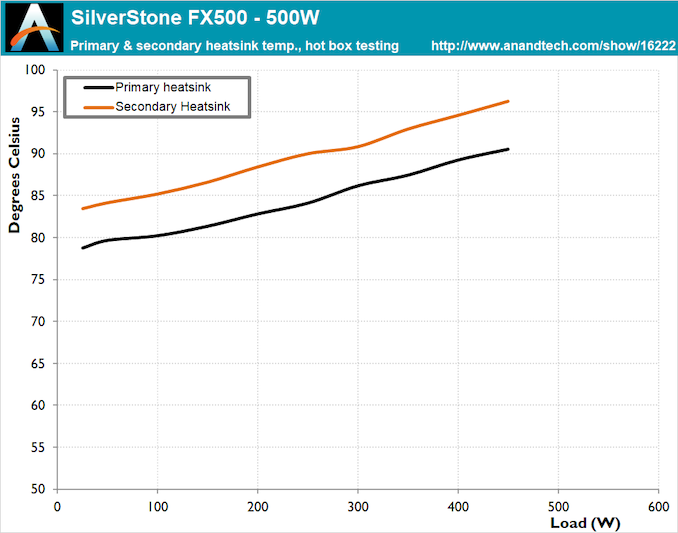The SilverStone FX500 Flex-ATX 500W PSU Review: Small Power Supply With a Big Bark
by E. Fylladitakis on November 12, 2020 9:00 AM EST- Posted in
- Cases/Cooling/PSUs
- PSUs
- 80Plus Gold
- SilverStone
- 500W
- Flex ATX
Hot Test Results
| Main Output | ||||||||
| Load (Watts) | 100.85 W | 251.53 W | 374.45 W | 497.73 W | ||||
| Load (Percent) | 20.17% | 50.31% | 74.89% | 99.55% | ||||
| Amperes | Volts | Amperes | Volts | Amperes | Volts | Amperes | Volts | |
| 3.3 V | 1.24 | 3.36 | 3.09 | 3.34 | 4.64 | 3.32 | 6.19 | 3.3 |
| 5 V | 1.5 | 5.1 | 3.76 | 5.07 | 5.64 | 5.02 | 7.51 | 5 |
| 12 V | 7.37 | 12.08 | 18.42 | 12.06 | 27.63 | 11.97 | 36.83 | 11.94 |
| Line | Regulation (20% to 100% load) |
Voltage Ripple (mV) | |||||
| 20% Load | 50% Load | 75% Load | 100% Load | CL1 12V |
CL2 3.3V + 5V |
||
| 3.3V | 2% | 14 | 20 | 20 | 28 | 16 | 34 |
| 5V | 1.8% | 16 | 22 | 26 | 34 | 20 | 40 |
| 12V | 1.2% | 20 | 24 | 28 | 60 | 52 | 38 |
As can be seen in the preceding tables, the power quality of the SilverStone FX500 is good. The maximum voltage ripple on the 12V line is 60 mV, a figure that most high-end PSU admittedly surpass nowadays, but it's still exactly half of the ATX design guide's recommended 120 mV limit. Ripple on the secondary 3.3V/5V lines is equally mediocre, reaching 34 mV on the 5V line with a recommended maximum at 50 mV. Voltage regulation is good, at just 1.2% for the main 12V line and about 2% for the secondary 3.3V/5V lines.
Operation in high ambient temperatures greatly affects the performance of the tiny FX500. First and foremost, the PSU was unable to output all of its rated power output under these operating conditions, shutting down some minutes after the load was set at 500 Watts due to overheating. Taking the reduced nominal load range of between 20% and 90% into account, the average efficiency drops by 0.6% regardless of the input voltage, going down to an average of 89.9% (230 VAC) / 88.4% (115 VAC), figures that initially seem comparatively good but are deceptive due to the missing 100% load measurement.
As it can be derived from the charts below, the cooling capabilities of the SilverStone FX500 are unable to cope with the very adverse ambient conditions inside our hotbox. Although it operated normally at 100% for several minutes, it eventually shut down to protect itself. Given that our testing temperatures are higher than the 40°C that this unit is rated for, the FX500 held fairly well considering its small size. The real weakness here is that the small cooling fan is operating at maximum speed practically all the time. With noise figures constantly above 50 dB(A), the FX500 will be unbearably loud for home users under such operating conditions.















35 Comments
View All Comments
Lucky Stripes 99 - Friday, November 13, 2020 - link
I'm curious how the other cooling components in a SFF case would react to having a passive AC-DC PSU like that running at high loads. You might just be pushing the noise and heat issues to other parts of the case. It may be an acceptable trade-off if they can do the job more quietly, but it may not turn out as quiet as you might hope. For the price, there are better alternatives.plewis00 - Thursday, November 12, 2020 - link
Is this actually that impressive for size? How does it compare to an HP 1200W server PSU? Yes I know those are loud (at full load but manageable at low load) and 12V-only but they’re capable of 1200W sustained at 240V and Platinum-rated. So is this Silverstone that much of a feat?thecoolnessrune - Thursday, November 12, 2020 - link
Yes, I would definitely say it's still impressive. The Flex-ATX PSU is around 150mm long. Those 1U Server PSUs are over twice that, usually in the 330mm range. That leaves a lot more room more more circuity to get efficiency up in the Titanium range, and leaves a huge amount of room for heatsinking in the path of the air channel. In addition to that, the server PSU has an edge finger connector vs having to solder wires onto the PCB, further decreasing the real estate needed for functions that don't involve cooling the unit. A last point is that most of these modern server PSUs do not have the further conversion circuity for 5V and 3.3V busses. They outboard that to the Power Management Module. I'd say it's pretty impressive that they were able to cram wiring, low voltage conversion circuitry, and a ~450W power output in a 150mm chassis length. But it definitely came at a cost. An extra 50mm of length would have made a world of difference.plewis00 - Thursday, November 12, 2020 - link
Where on earth did you get the dimensions from? I just pulled one of the HP Common Slot PSUs from a Proliant in the office and it’s not that large - HP says they’re 3.81 x 8.63 x 19.05 cm which is not a lot bigger - and they can go up to 1200W. Yes they’re a bit larger and they don’t have wires but the edge connector takes up similar space to directly connected wires. They’re missing 5 and 3.3V rails but how much space do they take? A slightly larger PSU that is highly efficient and has a much higher wattage seems to be similar ballpark to me.versesuvius - Thursday, November 12, 2020 - link
Could you please read what you write at least once before publishing it? This kind of writing is becoming a trend in Anandtech (sign of the times?):"As a result, SilverStone one of the very few companies with true a variety of small form factor power and cooling solutions, rather than just a token device or two."
ElectroChem - Thursday, November 12, 2020 - link
The previous sentence is no better."It's a field that SilverStone has become so entrenched in that although other companies that produce compact PCs and related peripherals as well[sic[ , none of them as [sic[ really trying to be SilverStone's peer."
Would it kill them to hire a proof-reader?
justaviking - Thursday, November 12, 2020 - link
As long as we are on this topic... maybe it's just me, but...Page 1, third paragraph...
You wrote: "making company PSUs an underserved market"
Did you mean to say... *compact* PSUs...?
Ryan Smith - Friday, November 13, 2020 - link
Thanks guys!Ej24 - Thursday, November 12, 2020 - link
Wonder if you could easily swap that fan for a 40mm x 20mm noctua? That'd probably move just as much air and be quieter. Don't have a need for such a tiny psu. But I'm sure I could dream of a need lolLucky Stripes 99 - Thursday, November 12, 2020 - link
Just be mindful of the static pressure and air movement rating of the original fan and any replacement you purchase. You can probably shave a few db off with a Noctua versus stock, but I wouldn't expect miracles.